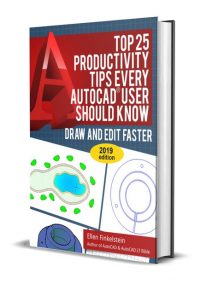AutoCAD 2000i has added the capability of assigning any color to objects in your drawing. You can define the color using the Red-Green-Blue system (RGB) or the Hue, Saturation, Value system to create any color you want, such as an object’s true color in real life. To use this feature, you need to create or […]
| |||||
Column text was introduced in AutoCAD 2008. Columns make fitting your text into tight spaces easier; it also looks more professional. You may have manually created columns in the past, but when you edited the text, the columns didn’t automatically readjust, leading to awkward spaces or lots of reformatting. Follow these steps to create column […] Don’t know which font to use? Until AutoCAD offers a WYSIWYG font drop-down list (send in your wish lists, folks!), you can print out truetype.dwg, which comes with AutoCAD in the /Sample folder. It probably doesn’t contain all the fonts on your computer but does have a sample of enough fonts for most people. Do you change your plot settings a lot? Do you plot drawings in various ways, for example, a draft plot and a final plot? Or do you create various layouts and need to plot them differently? You can save page setups, which contain settings for plotting. A page setup is attached to a layout, so […] AutoCAD supports Autodesk’s DXF (Drawing Interchange File) format, which is a text-only format that contains a 2D drawing’s information. The DXF format is often used to exchange drawings between different CAD programs. You can save a drawing in DXF format and you can open a DXF file in AutoCAD and save it as a drawing. […] You can use the EXPLODE command to break up the block into its components, but you don’t have control over layer, color, linetype, and so on. The XPLODE command gives you that control. Here’s how it works: Type xplode on the command line. At the Select objects: prompt, select one or more blocks. If you […] Since AutoCAD 2008, you can refine table styles with cell styles, which define formatting for table cells. A cell style is part of a table style, but has its own name. Follow these steps to create a cell style. Choose Draw> Table or choose Home tab> Annotate panel> Table to open the Insert Table dialog […] Blocks can contain attributes, which are labels with properties. For example, you can use attributes to attach price and manufacturer information to a block of an office chair. Once you have the attributes, you can extract them to a simple database and open that database in Microsoft Excel, for example, or insert it as a […] It’s always good to keep to your dimension styles as much as possible, but sometimes a situation requires an exception. You can create an override, which is a sub-dimension style that varies from its parent style. Follow these steps: On the Annotate tab, click the Dimensions panel’s dialog box launcher arrow (the arrow at the […] You can add formulas to a table, so that it automatically calculates the following: Sum Average Count (counts the cells in a column or row) Cell (displays the value of another cell) Equation (lets you manually insert a formula) This makes the table work like a spreadsheet. To add a formula, click outside the table […] | |||||
Copyright © AutoCAD Tips Blog 2020 - All Rights Reserved Privacy, Refund, and Other Legal Stuff Important: While we don't collect cookies, some of our 3rd-party services (such as PayPal and WordPress) do, to give you a safer and better browsing experience. Read about how we use cookies and keep your personal information secure by reading our Privacy Policy here. | |||||

 Instagram
Instagram LinkedIn
LinkedIn Facebook
Facebook 